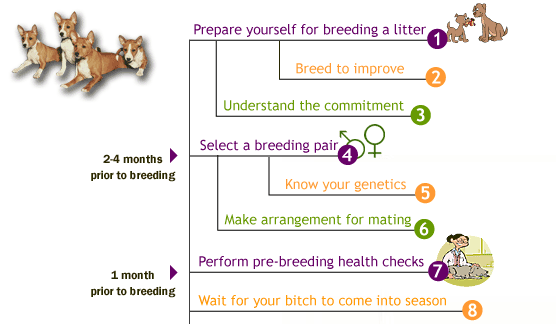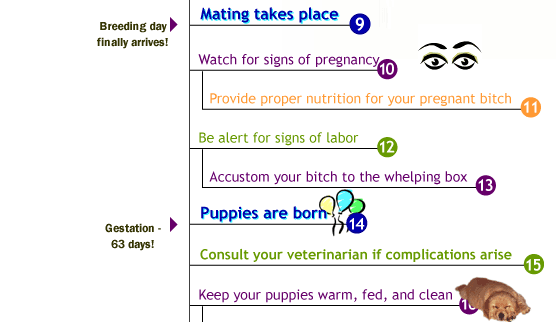|


Breeder Education
This is just a table for responsible breeding from the AKC
Use this template for any additional information you need such as products, pictures, fan clubs, links or just more information It's important to regularly change the content on your site and make updates to the information that you display. Doing this will help you to get more return visitors.
|
 |
wait for your dog to go into heat
The age at which dogs reach sexual maturity depends to a large extent on their breed. Small breeds tend to mature faster than large breeds. On average, however, males become fertile after six months of age and reach full sexual maturity by 12 to 15 months. Healthy stud dogs may remain sexually active and fertile to old age. Adult males are able to mate at any time.Bitches have their first estrus (also know as season or heat) after six months of age, although it can occur as late as 18 months to two years of age. Estrus recurs at intervals of approximately six months until late in life. During estrus, the female is fertile and will accept a male.Keep in mind that AKC Rules do not allow, except with special documentation, the registration of a litter out of a dam under 8 months or over 12 years of age at the time of mating, or by a sire under 7 months or over 12 years of age at the time of mating.
|
 |
mating takes place
Natural Breeding. Responsible breeders generally do not breed a bitch at the first heat, to avoid imposing the stress of pregnancy and lactation on a young, growing animal. It is also customary to avoid breeding a bitch on consecutive heats, to allow sufficient time for recuperation between pregnancies.Most dogs are first bred between the 10th and 14th day after the onset of proestrus. As long as the bitch will accept the male, mating every other day for a total of two or three matings is generally considered sufficient. However, signs of proestrus are not obvious in some bitches. To catch the peak fertile period, a veterinarian may need to perform hormone tests or examine vaginal smears under a microscope.Females are usually less inhibited by new environments, so bitches are usually taken to the stud. Breedings involving young males proceed smoother if they are paired with experience bitches. Sometimes human handlers must step in with assistance or guidance during breedings. Some breeds are more apt to need assistance than others because of anatomical considerations. Discussing this process with your own breeder will help you be prepared for the big event.
|
|
useful info
if you are a first time breeder and you follow these steps you have numerouse of successful litters.
|
|
Salect A breed
There is a simple principle to bear in mind in selecting breeding partners: Mate animals that complement one another. Choose a dog whose bloodlines will strengthen your dog's weaknesses and emphasize her good qualities. For example, if your dog's coat is not as good as it might be, then find a partner with a good coat, from a line of dogs with good coats. Of course, practicing this common sense maxim can be very complex, because you must weigh all the factors that contribute to the dogs' traits and appearances. This is an area where research and the advice and experience of other breeders are invaluable.
Two vital factors to keep in mind as you make your selection are temperament and health. Temperament is a hereditary trait in dogs, although it can be influenced by other external factors. Selection over many generations eventually produced breeds with the correct temperament to pull sleds, follow scent on trails or retrieve game. The inheritance factors of temperament are complex. However, you should never consider breeding a dog with a questionable temperament. You impose a major disservice on both human and canine communities if you produce another generation of skittish or bad-tempered animals.
|
|
This is one of my favorite images
This is my good friend Hal. I took this picture on his birthday. I think he likes to be in pictures.
|
|
|
|
|